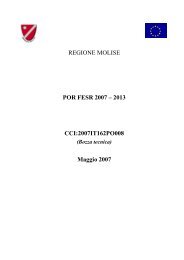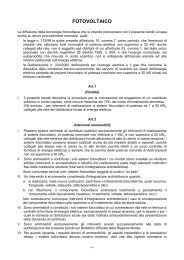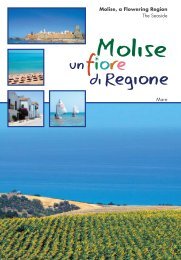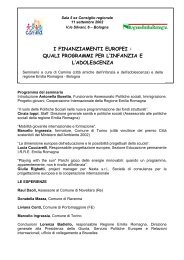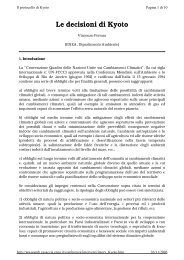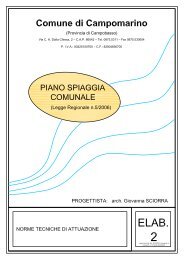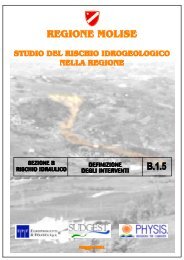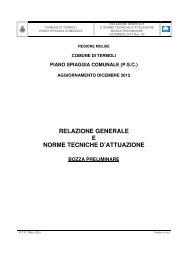Il Lago di Castel San Vincenzo e l'antica Terra ... - Regione Molise
Il Lago di Castel San Vincenzo e l'antica Terra ... - Regione Molise
Il Lago di Castel San Vincenzo e l'antica Terra ... - Regione Molise
Create successful ePaper yourself
Turn your PDF publications into a flip-book with our unique Google optimized e-Paper software.
Sopra: Camosci allo strato brado sulla dorsale <strong>di</strong> Monte Meta. (Foto V. Rufo)<br />
fruibili da persone<br />
con deficit motori o<br />
sensoriali, ai quali<br />
vanno aggiunti 3 specifici<br />
sentieri naturalistici<br />
(dati Ente Parco,<br />
2002). <strong>Il</strong> Parco protegge<br />
aree ancora selvagge,<br />
che aiutano ad<br />
immaginare come<br />
anticamente doveva<br />
presentarsi<br />
l'Appennino. <strong>Il</strong> suo<br />
territorio è montuoso,<br />
anche se i rilievi non<br />
sono molto alti: il<br />
monte Petroso (massima<br />
quota del Parco)<br />
raggiunge i 2.249<br />
metri. Nei suoi confini<br />
sono racchiusi<br />
quasi tutti gli ambienti<br />
appenninici: montagne<br />
aspre o dolci,<br />
pen<strong>di</strong>ci brulle o<br />
boscose, pascoli d'alta<br />
quota, faggete, boschi<br />
misti <strong>di</strong> caducifoglie,<br />
boschi <strong>di</strong> conifere.<br />
Anche la presenza<br />
delle acque (sia<br />
superficiali che sotterranee)<br />
è un'importante<br />
caratteristica del<br />
luogo. La vegetazione<br />
più importante presente<br />
è la faggeta,<br />
l'associazione forestale<br />
più estesa composta,<br />
oltre che dal<br />
Faggio, anche da altre<br />
specie quali l'Acero<br />
napoletano, l'Acero <strong>di</strong><br />
monte, il Tasso,<br />
l'Agrifoglio e la<br />
Betulla, che trova in<br />
questi territori uno<br />
dei pochi ambienti<br />
favorevoli<br />
dell'Appennino.<br />
The Abruzzo, Lazio and <strong>Molise</strong> National Park<br />
The most ancient among the Parks of the Apennine<br />
mountains has played an essential role in the preservation<br />
of some of the most important species of the Italian<br />
fauna: Marsican Brown Bear, Abruzzi Chamois and<br />
Wolf. Two thirds of the territory are covered with beech<br />
tree woods which represent one of the largest continuous<br />
extensions of the whole Apennine area, rich in ancient<br />
specimens allowing the presence of animals like the Lilford<br />
White-backed Woodpecker. The reintroduction of<br />
the deer and of the roe deer and the return of the wild<br />
boar gave the opportunity to rebuild, together with the<br />
great carnivores, the original food chains. Above the<br />
beech tree wood, the high-mountain stony grounds house<br />
formations of Swiss Mountain Pine, very rare in the<br />
Apennines, and a great number of species linked to these<br />
extreme environments, often relicts of the vegetation<br />
dating back to the glacial ages or endemic and localized<br />
species. The success of Parco Nazionale d'Abruzzo, Lazio<br />
e <strong>Molise</strong> lies also in the fact that it has been able to<br />
combine the conservation of the natural environment<br />
with the social-economic development of the local communities.<br />
The several Visitor Centers, the Faunistic<br />
Areas, the network of paths, and the other existing infrastructures<br />
have given the opportunity to revitalize small<br />
historical centers of great value.



